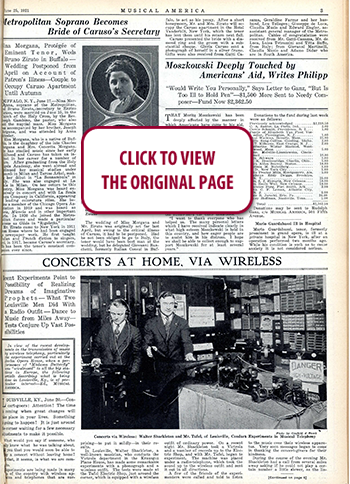 100 YEARS AGO IN MUSICAL AMERICA (401)
100 YEARS AGO IN MUSICAL AMERICA (401)
June 25, 1921
Page 3
CONCERTS AT HOME, VIA WIRELESS
Recent Experiments Point to Possibility of Realizing Dreams of Imaginative Prophets—What Two Louisville Men Did With a Radio Outfit—Dance to Music from Miles Away—Tests Conjure Up Vast Possibilities
In view of the recent developments in the transmission of music by wireless telephony, particularly the experiment carried out at the Berlin Opera House, when a performance of “Madama Butterfly” was “wilrelessed” to all the big stations in Europe, the following article describing what is being done in Louisville, Ky., is of particular interest—Ed., MUSICAL AMERICA.
LOUISVILLE, KY., June 20. —Concert-goers: Attention! The time is coming when great changes will take place in your lives. Something is going to happen! It is just around the corner waiting for a few necessary adjustments to make it possible.
What would you say if someone, who really knew what he was talking about, told you that you would soon be able to enjoy a concert without leaving home? For that, it seems, is what we are come to.
Experiments are being made in many parts of the country with wireless apparatus and telephones that are surprising—to put it mildly—in their results.
In Louisville, Walter Shackleton, a well-known musician, who conducts the Victrola department in the Krausgill Piano House, has made some remarkable experiments with a phonograph and a wireless outfit. The tests were made at the Tafel Electric Shop, just around the corner, which is equipped with a wireless outfit of ordinary power. On a recent night Mr. Shackleton took a Victrola and a number of records up to the Electric Shop, and with Mr. Tafel, began to experiment. The machine was placed under a radio-telephone, which took the sound up to the wireless outfit and sent it out in all directions.
A few of the friends of the experimenters were called and told to listen to the music over their wireless apparatus. Very soon messages began to come in thanking the concert-givers for their kindness.
During the course of the evening Mr. Shackleton had a call from several miles away asking if he could not play a certain number a little slower, as the listeners at this point had put an amplifier upon their telephone and were dancing to the music. This suggested to the concert-givers the idea of using an amplifier upon their own receiving apparatus, with the result that the music that came into the room was many, many times louder than the sounds produced by the gramophone in the room a few feet away.
Mr. Shackleton is now planning to give wireless concerts once a month, at the time when the new records come out. Many of his customers have wireless outfits, or can get at them handily, and in this way may hear all the new records at home, or very close to home, and thus avoid the trouble of going to the shop and hearing them in the ordinary way. Announcements of the concerts and programs will be printed in the afternoon papers and auditors will only have to cut these out and follow the selections as they would in any concert hall.
The step from the automatic musician to the artist himself is an easy one. The latter will only have to occupy the position of the machine and sing, play or talk as he would when making a record. The radio-telephone, the wireless apparatus and the amplifiers will do the rest. And a perfectly comfortable audience will sit quietly at home and enjoy them. It does not require much imagination to picture the ultimate developments. Instead of rushing through a meal to get to a concert, one will be able to hear the program without leaving the table. Vast possibilities are opened up. Think of churches, restaurants, dinners, weddings supplied with music from a central point! —HARVEY PEAKE.




 RENT A PHOTO
RENT A PHOTO





